#anthony frieze
Text
My own for fun fleshing out of the idea posited by Jonathan Morris that the other voices Xoanon adopts in the Face of Evil are forgotten incarnations plucked from the Doctor's subconscious.
Specifically played by Pamela Salem, Rob Edwards, Anthony Frieze and Roy Herrick.
The First Xoanon Doctor (Pamela Salem)
This incarnation was posted on Earth by her request, as part of the Time Lords solidifying of the Web of Time as history, arriving in the era of the First World War. Upbeat and playful, she had a knack for outmanoeuvring her opponents even in spite of the cultural pushback against the form this incarnation took. She also often came across as anachronistic due to a lack of understanding of the culture of the era of this planet that she was assigned to. She, however, was occasionally prone to seeing humans more as interesting specimens than individuals in their own right.
The Second Xoanon Doctor (Rob Edwards)
Coming across as an eccentric but kindly Professor-like figure, wearing a scruffier version of a formal outfit. This incarnation took up teaching on Earth. He was heavily interested in the idea of luck as an external force and wore a clover on his lapel to represent that. He was prone to meddling in events outside his purview, but only subtly, within his remit as an agent of the Time Lords and thus often employed luck or what appeared to be luck as a ‘weapon’ of sorts in said situations, despite his pleasant exterior he was capable of doing almost anything if he thought it would benefit the ‘greater good’. He was the first incarnation to meet the Abbot.
The Third Xoanon Doctor (Anthony Frieze)
This incarnation lived for a long time, aging up from a child to an adult. He spent a lot of his time on Gallifrey, getting involved in the internal politics of the planet as an advocate for the Non-Intervention policy. He regretted the meddling his immediate predecessor was prone to, though he still returned to Earth to observe the planet and would occasionally intervene if he found a situation significant enough to warrant it. He was brash and abrasive, and had a superiority complex, but still was a kind-hearted person when the chips were down. He met his end in service to Gallifrey in the midst of a Time War.
The Fourth Xoanon Doctor (Roy Herrick)
A calmer, younger, mellower incarnation. This Doctor prided himself on his moral compass, whilst he still acted as an agent for the Time Lords, he treated the role as secondary to his interest in the planet Earth and its people. He was granted an official remit to travel across the Universe, rather than just the history of the planet he was observing, as a result of a great service to Gallifrey during his early life. He was also one of few early incarnations of the Doctor who contemplated any form of relationship with a human, though he ultimately never went through with it. Despite this, he still maintained a wide social network in the era to which he was assigned.
(Did an amateur artwork, also including headcanons for the 'eras' under the assumption of them directly preceding the Morbius Doctors from Forgotten Lives)
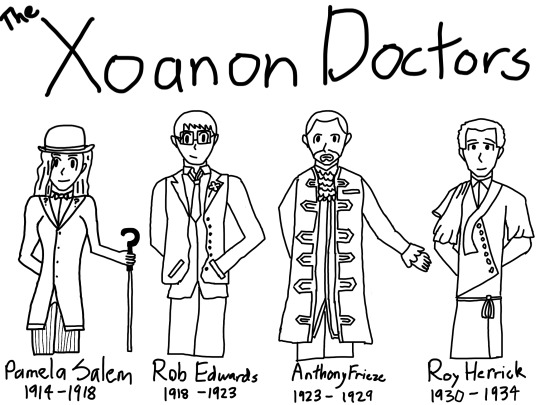
#doctor who#dweu#doctor who eu#forgottenlives#forgottenlivesobverse#morbius doctors#xoanon doctors#pamela salem#rob edwards#anthony frieze#roy herrick#obverse books
25 notes
·
View notes
Photo

This mansion in Oakland Township, Michigan, isn’t historic- it was built in 2005, but it features hand-carved wooden archways, hand-painted ceiling frescos, hand-cut stone and gold-leafed accents. It’s on the market and has been reduced to $10.8M.

International antiquities and fine art throughout the 16,500 sq. ft. home are included with the sale. (They convey! Hurray!) And, it has a total of 118 rooms. It would take several days to even go through your new home.

Let’s tour this insanely majestic place.

When they said there’s hand carved wood, they weren’t kidding. Look at the details on all this wood.
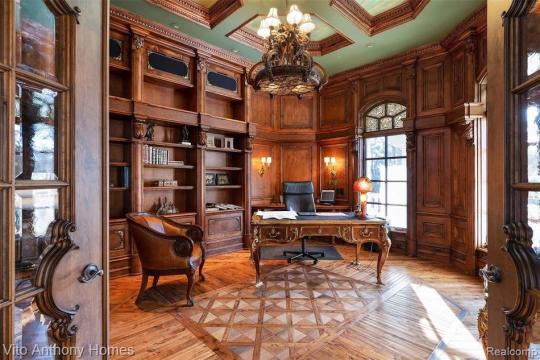
Right off the entrance hall is a stunning home office. I mean, if you can afford a $10.8M home, you probably need an office.
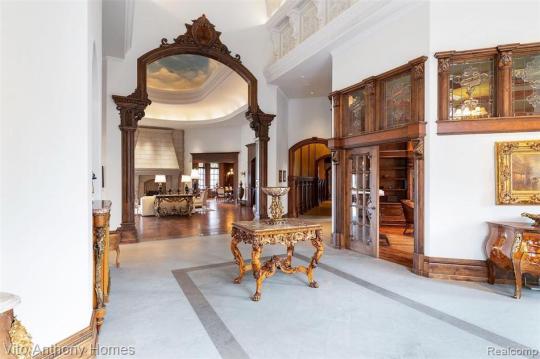
Geesh. There are framed leaded glass windows around the wall. And, look at the arch leading into the sitting room.
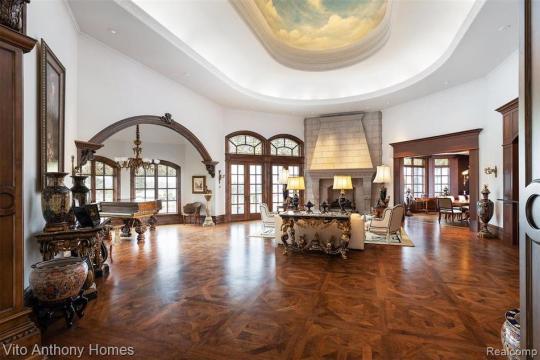
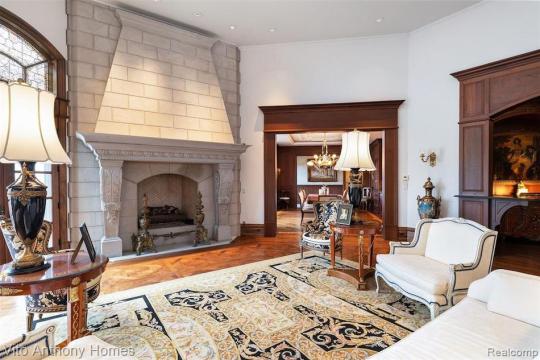
There’s one of the ceiling frescoes and look at that fireplace that looks straight out of medieval castle.

Look at this bar area.

The gorgeous dining room- look at the border on the floor.

The kitchen has it’s own living room.
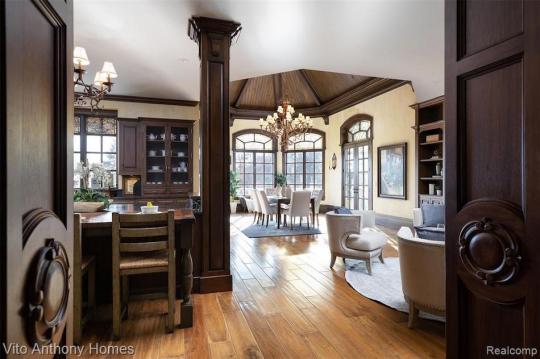
Beautiful sunny breakfast room has a fabulous ceiling all to itself. The columns. There are several types of wood in the kitchen.

They made it look like the stove is in an old cooking fireplace.
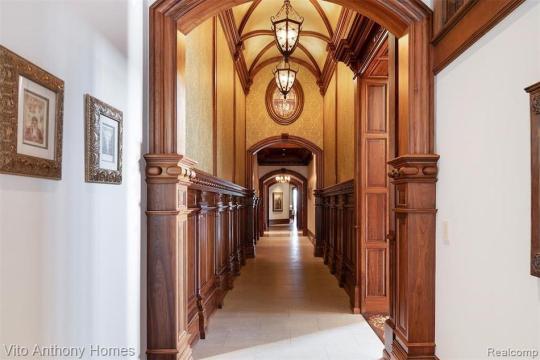
This hall doesn’t even look like a home- it’s like a church or university.
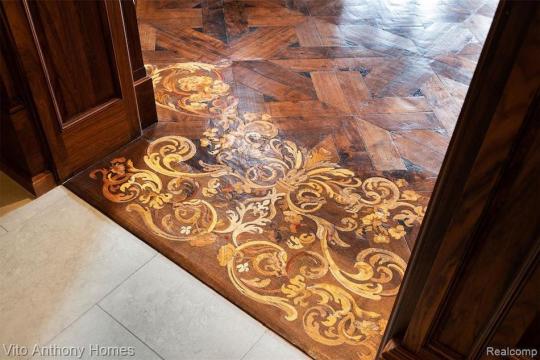
The inlay on this floor is so intricate.
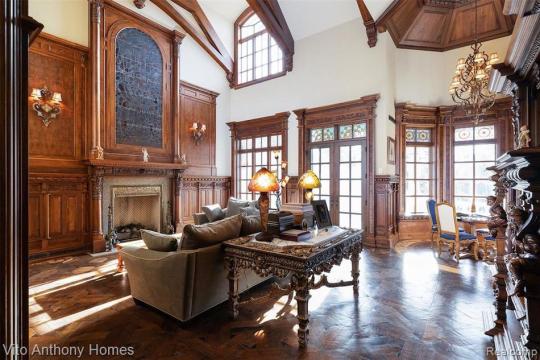
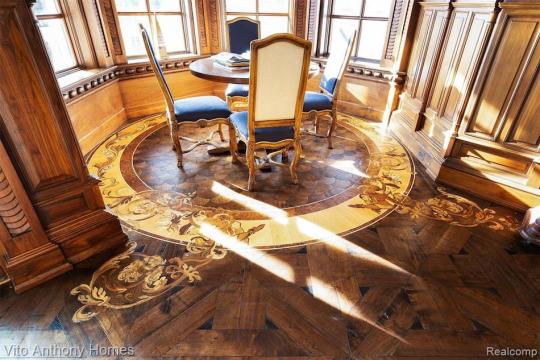
This house is outrageous. The carved wood, the different ceilings, and the floors are all magnificent.
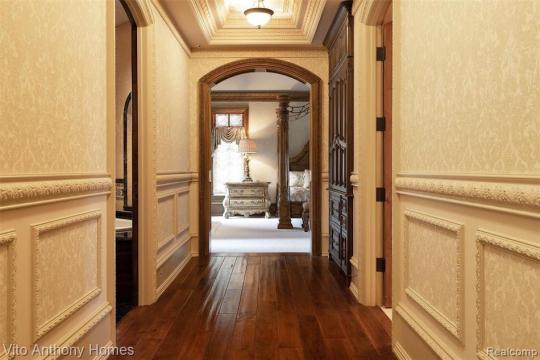
I’m going to guess that this is another wing, b/c the hall is different. We’re headed to the main bd.

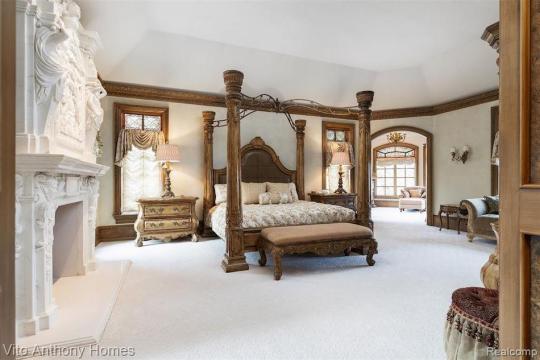
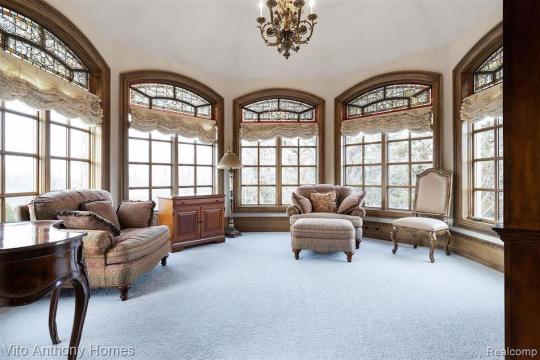
Good lord! Look at this fireplace. Doors open to a terrace on one side, and on the other there’s a sitting room.

In the en suite, this is just the room for the sinks. That’s the Lord of the manor’s bathroom on the left.

And, this is the Lady of the manor’s bath.

His Lordship’s closet- notice the security system.
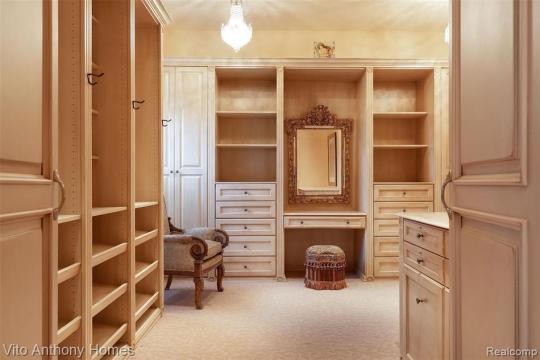
Her Ladyship’s dressing room matches her bathroom. I like the other bathroom better, though.

There’s also a beautiful laundry room- how nice of them to give the help such a nice work space.

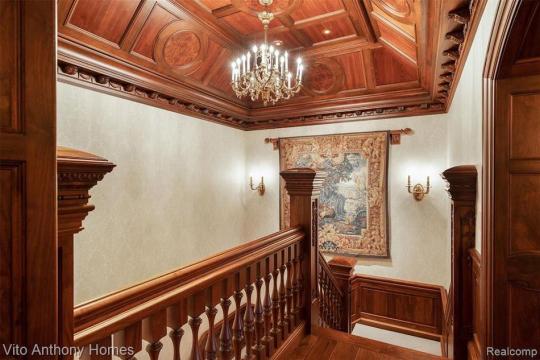
There must be an elevator somewhere w/all these stairs.
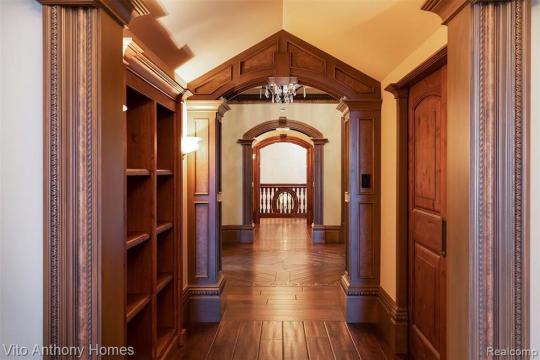

There are more bds. up here.


In this huge house there are 7 bds., but 10.5 baths.
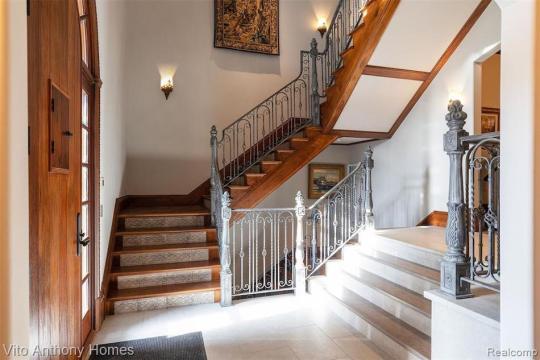
This must be a rear staircase, or another wing.

Are we in the basement?

Found it!

More stairs. What a pretty stained glass window.
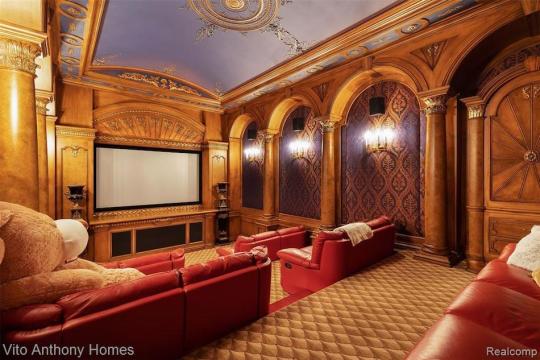
What an elegant home theater.


Bar and rec room.

Gotta have another kitchen here. That must be a house phone to call the staff, on the right.


There’s even a frieze over the pool and the built-on hot tub.

Nice brick loo down here.


Look at the power plant for this place. This is crazy- you need an engineer to run the house.
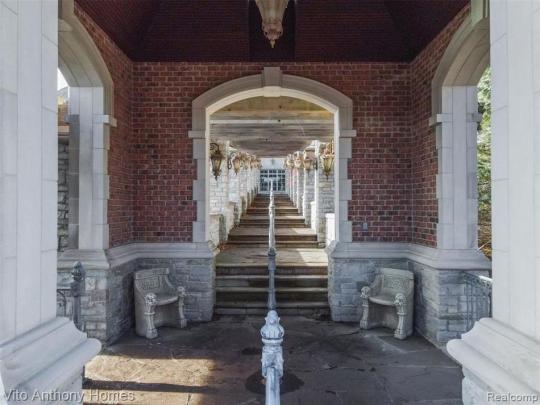

Insane.
https://www.priceypads.com/16500-sq-ft-vito-anthony-homes-built-brick-manor-in-oakland-township-michigan/?
594 notes
·
View notes
Text

Rare bust representing Amphitrite in shells, mother-of-pearl, pearls, blackened wood and corals, late 19th century / early 20th century
The bust is worked in the taste of Anthony Redmile's productions.
It rests on a blackened wooden and gilded bronze base in the Louis XVI style.
Gilded bronze elements with laurel friezes are integrated into her hair.
The corals of white and painted red colors are of the species Acropora Florida (category II/B).
Bonhams
22 notes
·
View notes
Text
Which artist I think wayv members would be drawn by:

♡𝐊𝐮𝐧 could be drawn by 𝐕𝐢𝐧𝐜𝐞𝐧𝐭 𝐕𝐚𝐧 𝐆𝐨𝐠𝐡♡

❥Vase with the twelve sunflowers, 1888
❥Self portrait, 1887
❥People strolling in a park in Paris, 1886
❥Wheat field with Cypresses, 1889
❥ Self-portrait with grey felt hat, 1887
❥Meadow in the mountains: Le Mas de Saint-Paul, 1889
♡𝐓𝐞𝐧 could be drawn by 𝐘𝐢𝐳𝐡𝐞𝐧𝐠 𝐊𝐞♡
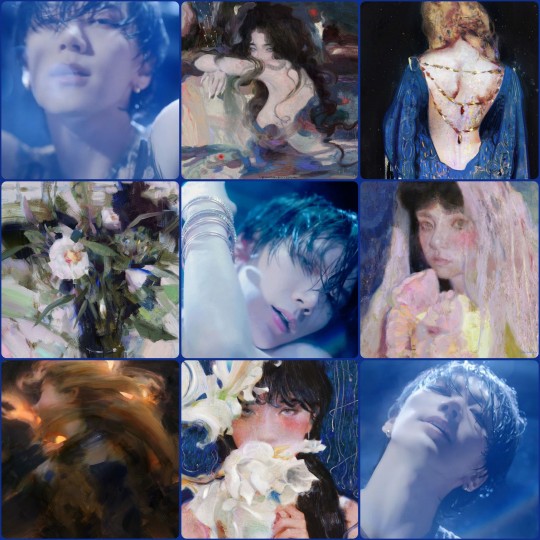
❥7-30
❥7-26
❥7-4
❥Pink+!
❥0_0
❥6-27 6-28
♡𝐖𝐢𝐧 𝐰𝐢𝐧 could be drawn by 𝐏𝐢𝐞𝐫𝐫𝐞-𝐀𝐮𝐠𝐮𝐬𝐭𝐞 𝐑𝐞𝐧𝐨𝐢𝐫♡
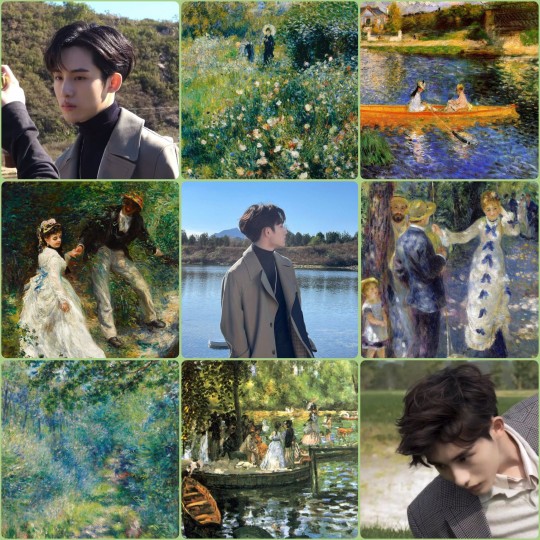
❥Woman with a parasol in a garden, 1875
❥The skiff, 1875
❥La Promenade, 1870
❥The swing, 1876
❥Path through the woods, 1874
❥La Grenouillere, 1869
♡𝐗𝐢𝐚𝐨𝐣𝐮𝐧 could be drawn by 𝐂𝐥𝐚𝐮𝐝𝐞 𝐌𝐨𝐧𝐞𝐭♡

❥The water lily pond, 1899
❥Water lilies, 1919
❥Women in the garden, 1866
❥Irises, 1914
❥Luncheon on the grass, 1865-66
❥On the bank of the Sienne, Bennecourt, 1868
♡𝐇𝐞𝐧𝐝𝐞𝐫𝐲 could be drawn by 𝐆𝐮𝐬𝐭𝐚𝐯 𝐊𝐥𝐢𝐦𝐭♡

❥Water serpents ii, 1907
❥Beethoven frieze, 1902
❥Portrait of Adele Bloch-Bauer i, 1903-07
❥Danae, 1908
❥The kiss, 1908
❥Lady with a fan, 1918
♡𝐘𝐚𝐧𝐠𝐲𝐚𝐧𝐠 could be drawn by 𝐒𝐚𝐥𝐯𝐚𝐝𝐨𝐫 𝐃𝐚𝐥𝐢♡
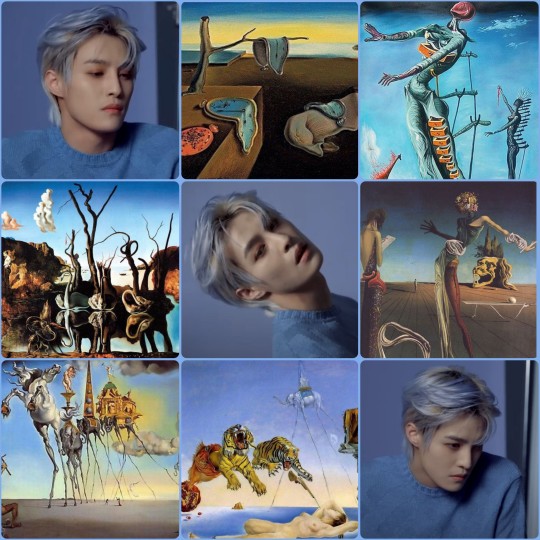
❥The persistence of memory, 1931
❥The Burning Giraffe, 1937
❥Swans reflecting elephants, 1937
❥Woman with a head of roses, 1935
❥The temptation of St. Anthony, 1946
❥Dream caused by the flight of a bee around a pomegranate a second before awakening, 1944

#nctzen#wayv#wayv icons#wayv moodboard#wayv ten#ten#yangyang#liu yangyang#ten lee#qian kun#kun#wayv kun#wayv yangyang#wayv winwin#wayv sicheng#dong sicheng#nct sicheng#winwin#ten chittaphon#chittaphon leechaiyapornkul#hendery#wayv hendery#xiaojun#wayv xiaojun#xiao dejun#paintings#gustav klimt#salvador dali#pierre auguste renoir#vincent van gogh
31 notes
·
View notes
Text
Some cutscenes with my oc Anthony :")
Anthony is a tomboy character who works in the butcher shop of the city and say that when it is Halloween they likes to dress also and gives sweets that have the appearance of ground meat haha.
They're a calm person But they likes to have fun too, when they gets angry they doesn’t show it but if they gets very angry their expression will change completely on a cold face making that person uncomfortable.
interesting fact about Anthony is that they knows to distinguish the steps of the people when this turned of backs
The relationship they had with Bob was a friendship but with the pass of time when he tried to kill her (that explains the scar on his cheek) was changing, Anthony had become a cold person for a period but was gradually forgetting what had happened, but. When they found out Bob had gotten out of prison, they went on alert for anything.
Yes, also as a half city she knows Skid and Pump, she likes they presence when it is Halloween, In the image we can see how Anthony is a little tired because when he discovered Bob on the part of the frieze where the cold meat was he jumped on her with the attempt to kill her but only made a wound next to her stomach making a big cut.



#spooky month#spooky month 5#tender treats#bob spooky month#bob velseb#spooky month bob#spooky month tender treats#skid and pump#spooky month lila#spooky month jaune#cutscenes#spooky month oc
17 notes
·
View notes
Text








Belladonna of Sadness (1973), dir. Eiichi Yamamoto + Art History
The Nightmare, Johann Heinrich Füssli, 1781 – Detroit Institute of Art
Christ Carrying the Cross, Hieronymus Bosch, c. 1510 - 1535 – Ghent Museum of Fine Arts
Maithuna frieze (detail), Khajuraho, Madhya Pradesh, India
The Temptation of St Anthony, Félicien Rops, 1878 – Royal Library of Belgium
6 notes
·
View notes
Text

37 Carvings - Carvings & Sculpture from the Bible! 15 & 16th Century. With Footnotes -# 6
The frieze composition is based on an iconographic scheme dating back to at least the thirteenth century. Displaying a solid classical culture, the sculptor locks the figures in a closed and compact composition. Reducing the number of mourners is crucial in the final outcome of the composition. Limiting the number of actors is, moreover, strictly Orthodox; to distance himself from the Apocrypha and other non - canonical texts, common sources of inspiration for this sculpture theme. The pair of women who accompanied Joseph of Arimathea derived from the Gospel story of Matthew and Mark and Nicodemus of John…
Please follow link for full post
Saint Rita,Saint Nepomuk,Juan de Juni,SAINT ANTHONY,Donatello,Saint Francis Xavier,Bible!,Michelangelo,Holy Barbara,Saint Peter,Saint Vicente,
#Icon#Bible#biography#History#Jesus#mythology#Paintings#religion#Saints#Zaidan#footnote#fineart#Calvary#Christ
2 notes
·
View notes
Photo

Meadow Brook Hall in Rochester, Michigan
This grand mansion was the home of Matilda Dodge Wilson, widow of carmaker John Dodge, and her second husband Alfred G. Wilson. It was built in 1926-1929 and designed by the firm Smith, Hinchman, and Grylls which also designed Detroit’s Guardian Building. Buhl Building, Ford Piquette Plant, and the Dodge Main Factory, among many others. The 110-room Tudor Revival mansion is the fourth-largest historic house museum in the United States and is on the National Register of Historic Places. Each of its 36 chimneys has a distinct design and stone carvings on the exterior featuring the Dodge and Wilson family crests and native woodland animals. The study has a carved oak frieze with scenes from the life of Alfred Wilson. There's also a secret staircase, gold-plated bathroom fixtures, an Aeolian organ, Tiffany glass, and paintings by Anthony van Dyck, Thomas Gainsborough, and John Constable. The grounds include a golf course, stables, and Knole Cottage, a fully functioning playhouse with a kitchen, dining room, living room, bathroom, nursery, and bedroom. Born to German immigrants, Matilda Rausch Dodge Wilson had a notable life in industry, agriculture, politics, and education, and was one of the wealthiest women in the world during her lifetime. She was John Dodge’s secretary before marrying him and acted as a manager in the Dodge Brothers’ company. After being widowed with three children and three stepchildren, she remarried lumber baron Alfred Wilson and adopted two more children. She oversaw livestock breeding of shorthorn cattle and Yorkshire hogs. In 1931, Dodge was appointed to the Michigan State Board of Agriculture and in 1940 became the 43rd Lieutenant Governor of Michigan—the first female Lieutenant Governor in the country. In 1957, the Wilsons gave the property and extensive grounds to found Oakland University. Since 1971, Meadow Brook Hall has been open as a museum, conference space, and cultural center. For many years the home hosted one of the largest car shows in the world. In more recent times, Antiques Roadshow was filmed here, as well as a number of music videos.
https://www.atlasobscura.com/places/meadow-brook-hall
0 notes
Photo










“Palanquin” [Stainless steel, 1987-1991] _ Sculptor: Anthony Caro _ Photographs by Spyros Kaprinis [16.09.2021]
“Palanquin is a sculpture, as Caro said, ‘on the border of architecture’. Its interior space suggests a room, but, unlike architecture, this is not for habitation. Instead, the structure is treated in an imaginative and playful way.”
Frieze Sculpture, English Gardens, The Regent's Park, London _ 14.09.2021 - 31.10.2021.
https://www.frieze.com/article/frieze-sculpture-returns-regents-park-2021
#Palanquin#Stainless steel#Anthony Caro#1987#1991#Sculpture#Architecture#Frieze Sculpture#English Gardens#Regent's Park#London#UK#Spyros Kaprinis#2021
5 notes
·
View notes
Photo
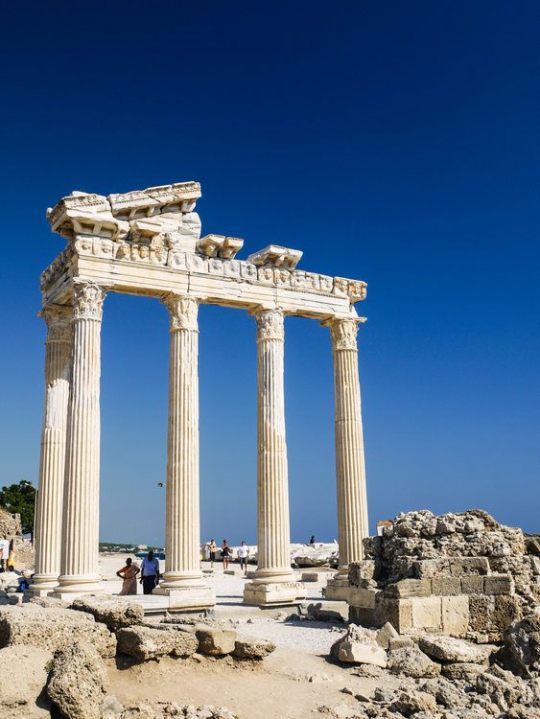
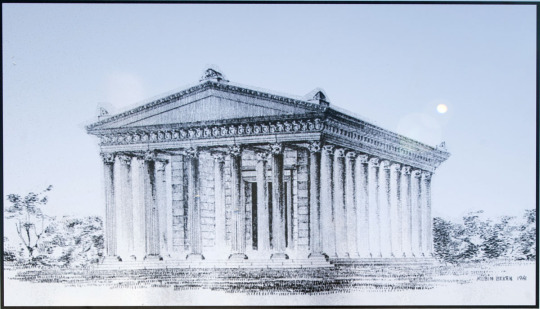

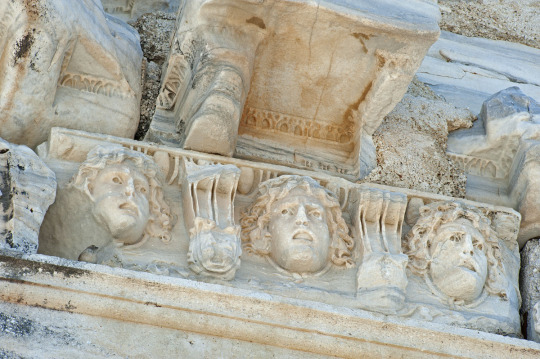




Temple of Apollo
Side, Asia Minor (Turkey)
2nd century CE
The Temple of Apollo is a hexastyle Corinthian temple in Side, Turkey. It originally had 6 front columns and 11 side ones. 5 of its columns were re erected in modern times. What made it different from other temples of that era, is its antechamber which had a pair of massive Corinthian columns. It is believed to be the place where Anthony met Cleopatra; he presented the Apollo Temple as a token of his love and devotion to her.
From an architectural point of view, this temple was a peripteros i.e. it was surrounded by a colonnade on all four sides of the inner chamber (called cella or naos). In the case of the temple of Apollo this colonnade was executed in the Corinthian order. Each longer side of the building was originally adorned with 11 columns and both shorter sides were decorated with 6 columns.
The stylobate of Apollo's temple, that is the top step of the platform on which colonnades of temple columns were placed, has the dimensions of about 16 meters (52 feet) by 30 meters (98 feet). Five columns that are currently standing were re-erected as part of the reconstruction work carried out in the 80s of the 20th century under the supervision of Professor Jale İnan. The frieze placed above them depicts the heads of Medusa - a mythological monster that had the face of a human female with living venomous snakes in place of hair.
The two main deities of Side in Roman era were Apollo and Athena. One of the two temples built in Side during the period known as the Roman Peace is the Temple of Apollo. Apollo is known as the god of music, poetry, sun, and light in Roman mythology. The other temple constructed in this period is the Athena Temple built in the honor of Athena, the goddess of wisdom and skill. These two temples lie close to each other on the tip of Side peninsula.
It is believed to be the place where Anthony met Cleopatra; he presented the Apollo Temple as a token of his love and devotion to her. (according to a local legend, and not backed by any account)
Sources: 1, 2, 3, 4, 5, 6

#art#Architecture#travel#history#roman#roman art#roman architecture#temple#apollo#mythology#Roman Mythology#temple of apollo#hexastyle#corinthian#side#turkey#Anatolia#Anatalia#asia minor
699 notes
·
View notes
Text
Amended Lives
Began a thirteen part loosely connected fanfic anthology series based around the Morbius Doctors, my own versions of the Xoanon Doctors and the dual homeworlds Censeron and Alkydron, first mentioned in 'Island on the Edge of Eternity' at the Cheshire House.
Currently four stories exist, a prologue starring the Fugitive Doctor and stories starring Anthony Frieze (Third Xoanon), Graeme Harper and Robert Holmes.
There's no consistent release schedule it'll just be whenever I feel like writing a part.
Other Forgotten Lives fanfics I also recommend
More Than Anything written by @mintyimperiatrix and starring the Douglas Camfield Doctor
An Unexpected Double Act by @heresmyfiddlestick and starring the Robert Banks Stewart Doctor in a MultiDoctor story with the Season 6B Second Doctor.
The Bank of Kartopolis written by @mintyimperiatrix and starring the Phillip Hinchcliffe Doctor
I also recommend checking out the various series on the Cheshire House. (@thecheshirehouse) There's some very fun ideas there and I'm incredibly impressed by what everyone has managed so far.
#forgottenlives#forgottenlivesobverse#dweu#doctor who#fanfic#doctor who fanfiction#morbiusdoctors#morbius doctors#the brain of morbius#fugitive doctor#jo martin#anthony frieze#robert banks stewart#phillip hinchcliffe#douglas camfield#graeme harper#robert holmes#robert holmes doctor#graeme harper doctor#douglas camfield doctor#the cheshire house#cheshirehouse#obverse books
12 notes
·
View notes
Photo
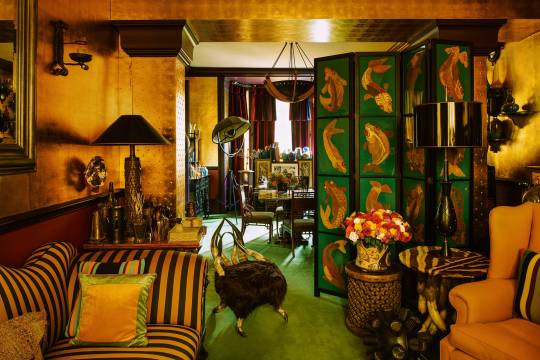
The exterior of Designer & Collector Anthony’s London Victorian townhouse doesn’t even hint at the unique interior. When he and his wife bought the house it was a run down place with squatters inside. But, look at it now.
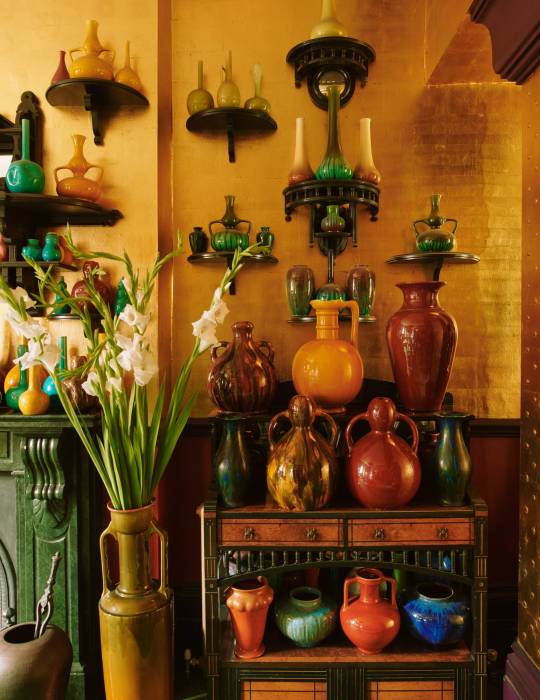
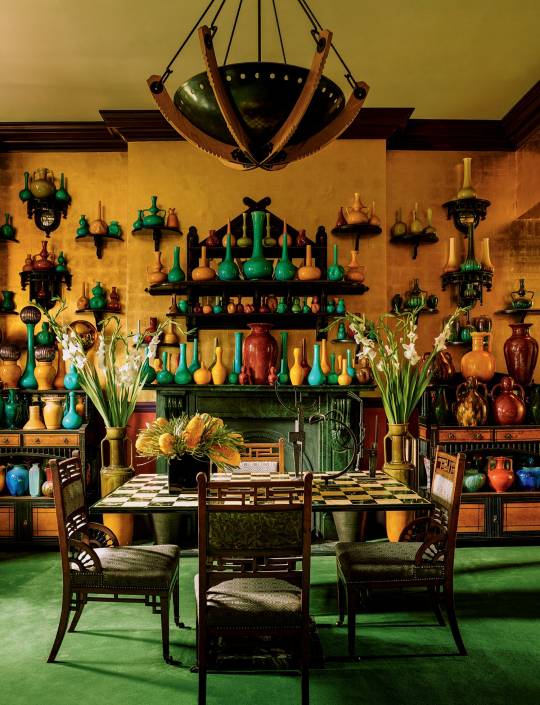
Walls in Dutch gold leaf showcase a collection of late-19th-century pottery. The folding table with a faux-marble painted top was designed by Anthony.
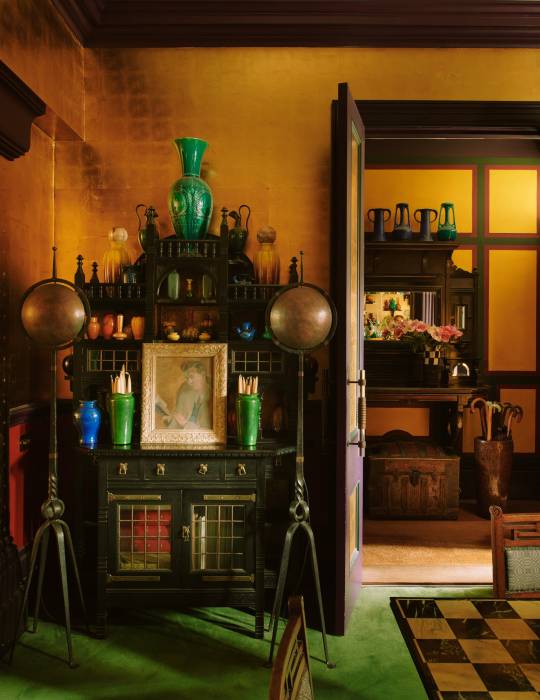
There are so many beautiful antiques in the home.
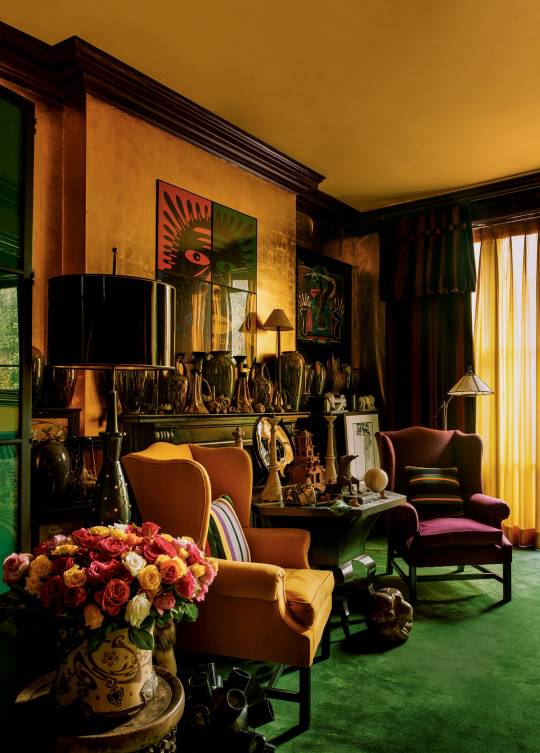
Armchairs upholstered in mustard and burgundy stand out on an apple-green wool carpet. The table, designed by Anthony, has a steel base topped with blue Brazilian granite.
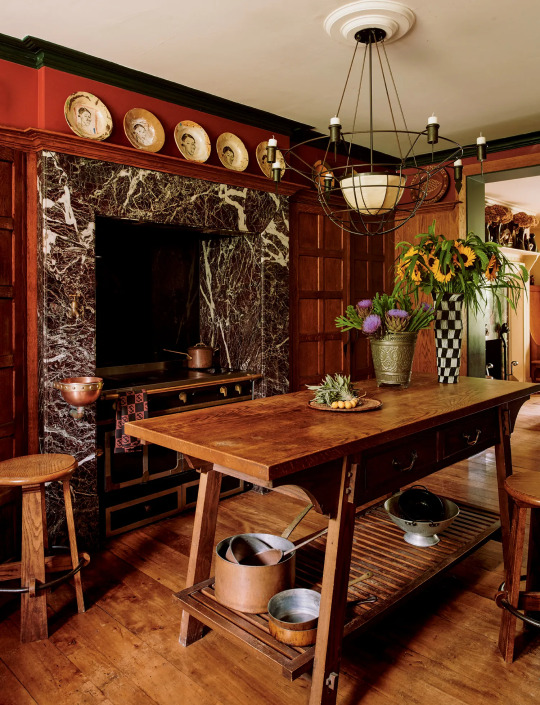
Anthony designed the table and had it built. Plates are displayed on an oxblood red frieze with a dark green cornice above. A marble surround frames a La range against paneling designed by Anthony.

A small table in front of the window displays foot and wood utensils.
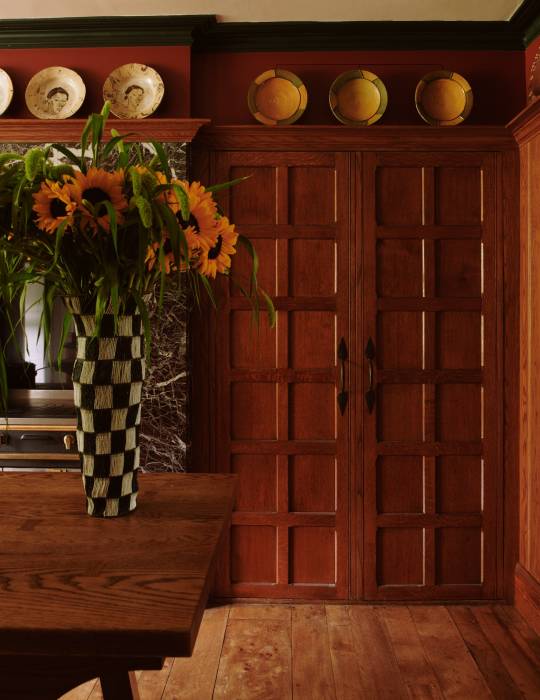
Beautiful wooden cupboards surround the kitchen.
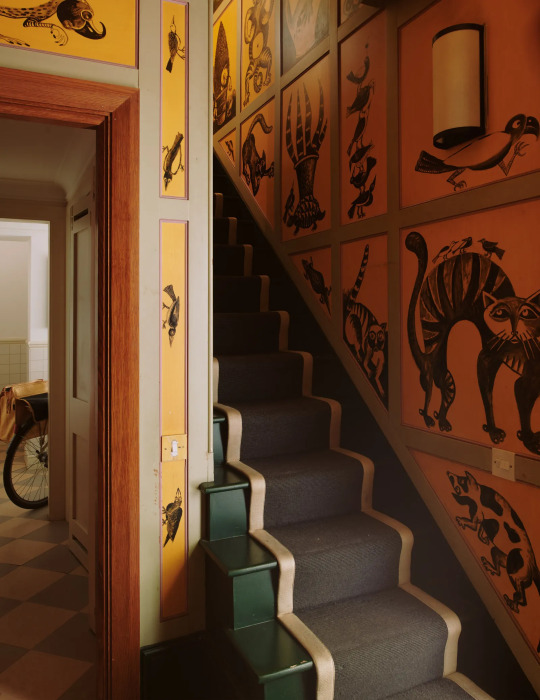
A painted array of fabulous beasts onto yellow panels are edged with a tiny pink bead of paint. A charcoal wool runner complements stairs painted a standard British racing green.
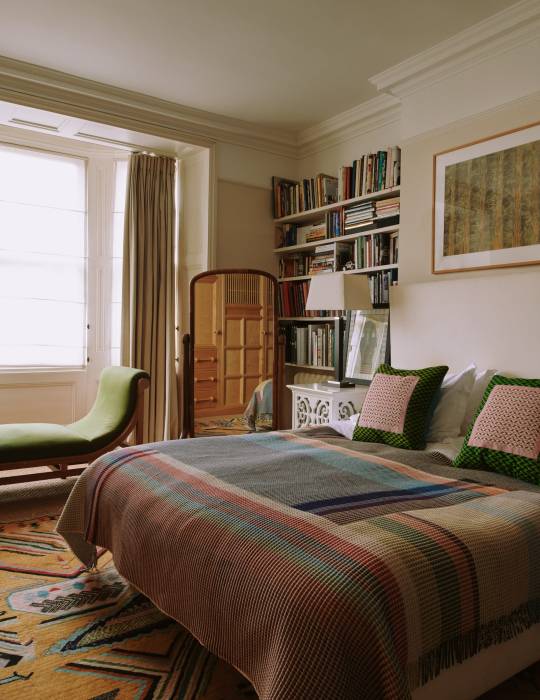
As always, the bedroom is minimalist and done in neutral tones. The carpet has a subdued colorful pattern.
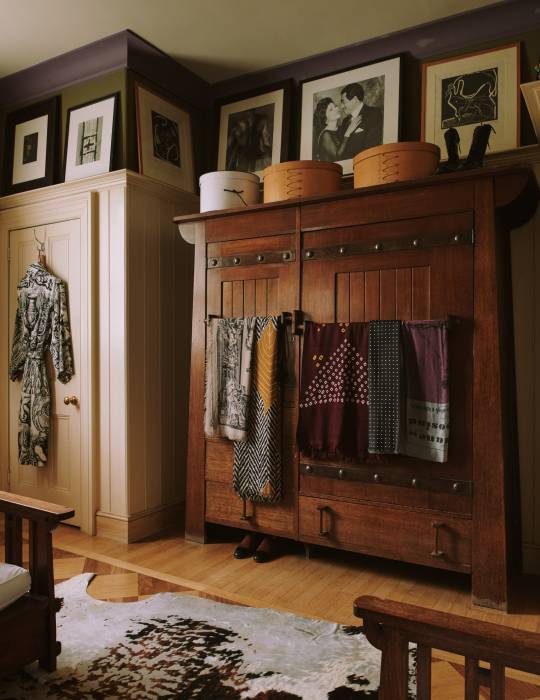
There’s also a beautiful closet with hanging bars on the doors.

The bath is also a calm neutral tone. The tub is an architectural salvage piece.


In the studio built by Anthony in the garden. The columns and frame for the 9 skylights in the ceiling are made from Douglas Fir trees.
https://www.houseandgarden.co.uk/gallery/tony-collett-house
55 notes
·
View notes
Photo




“An Object of Splendour, Costliness, and Beauty” — The Tomb of Henry VII and Elizabeth of York
1. Henry VII and Elizabeth of York’s bronze tomb effigies, by Pietro Torrigiano.
2. Foot of the tomb, with four brass cherubs holding the couple’s arms.
3. Bronze grille surrounding the tomb.
4. A medallion at the side of the tomb, depicting St George and St Anthony.
Three hundred years after its completion, the antiquarian John Britton described Henry VII and Elizabeth of York’s joint tomb as “in its perfect state, an object of splendour, costliness, and beauty.” Located at Henry’s magnificent Lady Chapel in Westminster Abbey, the couple’s bronze and black marble tomb was designed in the Renaissance style by the renowned Florentine sculptor Pietro Torrigiano. It is much like the one envisaged in Henry’s will, made a month before his death in 1509, where the King requested a tomb displaying his and Elizabeth's effigies “of copure and gilte.” Three years after Henry’s death, his son Henry VIII commissioned the present monument to his parents. He rejected the design of the original Italian sculptor, the respected Guido Mazzoni (Il Modanino), and entered into a contract with Torrigiano, who completed the tomb in 1517.
Henry and Elizabeth’s gilded bronze effigies show their recumbent figures laying side by side, hands raised, palms folded in prayer. Sumptuous pillows cushion the royal couple’s heads. The pair rest on a black marble tomb with a carved frieze, adorned with six wreath medallions in copper gilt representing the Virgin Mary and Henry’s favoured saints: Michael, George, Anthony, Christopher, Anne, Edward the Confessor, Vincent, Barbara, Mary Magdalene, John the Baptist, and John the Evangelist. Two brass cherubs sit at the couple’s feet holding the King’s arms; beneath, two more cherubs hold Elizabeth of York’s arms, topped by an imperial crown recalling her “waxen effigy in Royal robes, with ‘hair dishevelled’ and with her crown and sceptre.” The cherubs also once held pennants, which have since been lost. Around the edge of the tomb is a Latin inscription commemorating the couple as well as their son, Henry VIII:
Here is situated Henry VII, the glory of all the kings who lived in his time by reason of his intellect, his riches, and the fame of his exploits, to which were added the gifts of bountiful nature, a distinguished brow, an august face, an heroic stature. Joined to him his sweet wife was very pretty, chaste and fruitful. They were parents happy in their offspring, to whom, land of England, you owe Henry VIII.
Additionally, the tomb is enclosed by an ornate bronze “grate”, decorated with roses and the King's badges: the Red Dragon of Cadwaladr, the White Greyhound of Richmond, and the royal arms of England. Begun in Henry’s lifetime, the grille, worked by English artisans, is consonant with his will, which specified that “there be made in lenght and brede aboute the said tombe, a grate, in maner of a closure, of coper and gilte, after the faction that we have begoune.” The grille was once gilded, and on special anniversaries, many candles (each nine feet high) were lit on top. Four of the candles were to burn constantly, tended by the monks of Westminster. Thirty-two statutes once also sat in the niches of the grille, only six of which now remain: Saints George, Edward the Confessor, Bartholomew, James the Great, John the Evangelist and another. Like the tomb, the grille features a Latin dedication to the king:
Henry VII rests within this tomb, he who was the splendour of kings and light of the world, a wise and watchful monarch, a courteous lover of virtue, outstanding in beauty, vigorous and mighty; who brought peace to his kingdom, who waged very many wars, who always returned victorious from the enemy, who wedded both his daughters to kings, who was united to kings, indeed to all, by treaty, who built this holy temple, and erected this tomb for himself, his wife, and his children.
He completed more than fifty three years, and bore the royal sceptre for twenty four. The fifteenth hundredth year of the Lord had passed, and the ninth after that was running its course, when dawned the black day, the twenty first dawn of April was shining, when this so great monarch ended his last day.
No earlier ages gave thee so great a king, O England; hardly will ages to come give thee his like.
Sources: Westminster Abbey; June Schlueter, ‘Three early seventeenth-century watercolours of the tombs of Henry VII and Elizabeth I in Westminster Abbey,’ The Burlington Magazine, Vol. 151, No. 1281 (2009)
60 notes
·
View notes
Photo

Park Plaza Hotel / The MacArthur, Los Angeles, California
Photo by contributor Colby Stearns
I find myself wondering how tall each of those figures are.
From the LA Conservancy:
Rising eleven stories above Westlake Park, this grand concrete structure was a private retreat for the Benevolent and Protective Order of Elks, which once numbered thousands and included L.A.'s wealthy and powerful. The building contained 169 hotel rooms along with a gymnasium, pool, and bowling alley.
Designed as a memorial to World War I soldiers, the exterior features stylized Assyrian friezes, sculpted figures in military uniform, and massive cast stone warrior angels guarding the plinth and tower at every corner.
The lavish interior features an arched ceiling painted by famed muralist Anthony Heinsbergen, who purposely undercut the competition bidding for the job and toiled on his back while painting, like Michelangelo. Heinsbergen later claimed that he rarely bothered with self-promotion again.
The rich and famous who attended Lodge parties or masonic rights all saw his handiwork and requested Heinsbergen murals for their homes and businesses across Los Angeles. Below these murals hangs an ornate chandelier depicting Zodiac signs, and symbolic wrought ironwork surrounds the grand entrance.
The Elks sold the lodge in the 1960s as its membership diminished. The building has served as a YMCA, a retirement hotel, a venue for punk rock bands, and the Park Plaza Hotel. Its recently refurbished ballrooms, halls, and enormous foyer make it one of the most filmed locations in Los Angeles.
#art deco architecture#art deco#architecture#la architecture#los angeles#bpoe#elks lodge#park plaza hotel#submission
39 notes
·
View notes
Link
Early in the formidable new essay collection “Minor Feelings: An Asian American Reckoning,” the poet Cathy Park Hong delivers a fatalistic state-of-the-race survey. “In the popular imagination,” she writes, “Asian Americans inhabit a vague purgatorial status . . . distrusted by African Americans, ignored by whites, unless we’re being used by whites to keep the black man down.” Asians, she observes, are perceived to be emotionless functionaries, and yet she is always “frantically paddling my feet underwater, always overcompensating to hide my devouring feelings of inadequacy.” Not enough has been said, Hong thinks, about the self-hatred that Asian-Americans experience. It becomes “a comfort,” she writes, “to peck yourself to death. You don’t like how you look, how you sound. You think your Asian features are undefined, like God started pinching out your features and then abandoned you. You hate that there are so many Asians in the room. Who let in all the Asians? you rant in your head.”
Hong, who teaches at Rutgers, is the author of three poetry collections, including “Dance Dance Revolution,” which was published in 2007, and is set in a surreal fictional waystation called the Desert, where the inhabitants speak a constantly evolving creole. (“Me fadder sees dis y decide to learn Engrish righteo dere,” the narrator says.) “Minor Feelings” consists of seven essays; Hong explains the book’s title in an essay called “Stand Up” that centers on Richard Pryor’s “Live in Concert.” Minor feelings are “the racialized range of emotions that are negative, dysphoric, and therefore untelegenic.” One such minor feeling: the deadening sensation of seeing an Asian face on a movie screen and bracing for the ching-chong joke. Another: eating lunch with white schoolmates and perceiving the social tableaux as a frieze in which “everyone else was a relief, while I felt recessed, the declivity that gave everyone else shape.” Minor feelings involve a sense of lack, the knowledge that this lack is a social construction, and resentment of those who constructed it.
In “The End of White Innocence,” Hong describes her childhood home as “tense and petless, with sharp witchy stenches.” Her father drank; her mother, she writes, “beat my sister and me with a fury intended for my father.” Her parents grew up in postwar poverty in Korea—as a child, her father caught sparrows to eat. In order to get a visa to immigrate to the United States, he pretended to be a mechanic, and ended up working for Ryder trucks in Pennsylvania, where he was injured, and fired. He moved to Los Angeles and found a job selling life insurance in Koreatown, then bought a dry-cleaning supply warehouse, and became successful enough to send Hong to private high school and college. He recognized that Americans valued emotional forthrightness in business and developed a particular way of speaking at work. “Thanks for getting those orders in,” Hong remembers him saying on the phone. “Oh, and Kirby, I love you.”
Hong feels ashamed, but not of her proximity to awkward English, or her features, or witchy domestic stenches. “My shame is not cultural but political,” she writes. She is ashamed of the conflicted position of Asian-Americans in the racial and capital hierarchy—the way that subjugation mingles with promise. “If the indebted Asian immigrant thinks they owe their life to America, the child thinks they owe their livelihood to their parents for their suffering,” Hong writes. “The indebted Asian American is therefore the ideal neoliberal subject.” She becomes a “dog cone of shame,” a “urinal cake of shame.” Hong’s metaphors are crafted with stinging care. To be Asian-American, she suggests, is to be tasked with making an injury inaccessible to the body that has been injured. It is to be pissed on at regular intervals while dutifully minimizing the odor of piss.
For a long time, Hong recounts in the book’s first essay, she did not want to write about her Asian identity. By the time she began studying for her M.F.A., at the Iowa Writers’ Workshop, she had concluded that doing so was “juvenile”—and she couldn’t find the right form, anyway. The confessional lyric felt too operatic, and realist fiction wasn’t right, either: “I didn’t care to injection-mold my thoughts into an anthropological experience where the reader, after reading my novel, would think, The life of Koreans is so heartbreaking!” In “Stand Up,” she asks, “Will there be a future where I, on the page, am simply I, on the page, and not I, proxy for a whole ethnicity, imploring you to believe we are human beings who feel pain?” The predicament of the Asian-American writer, as Hong articulates it, is to fear that both your existence and your interpretation of that existence will always be read the wrong way. At Iowa, Hong noticed other writers of color stripping out markers of race from their poems and stories to avoid being “branded as identitarians.” It was only later that Hong realized that all of the writers she had noticed doing this were Asian-American.
I read “Minor Feelings” in a fugue of enveloping recognition and distancing flinch. I have tended to interpret my own acquiescence to and resentment of capitalism in generational terms rather than racial ones; many people my age seem to accept economic structures that we find humiliating because we reached adulthood when the margins of resistance appeared to be shrinking. I know, too, that my desire to attain financial stability is connected with a hope, bordering on practical obligation, to protect my parents, as they grow older, from the worst of the country that they immigrated to for my benefit. But, for some reason, I haven’t written very much about that. Was I, like Hong’s grad-school classmates, afraid of being branded as an identitarian? Had I considered the possibility of being positioned as a proxy for an entire ethnic group, and, unlike Hong, turned away?The term “Asian-American” was invented by student activists in California, in the late sixties, who were inspired by the civil-rights movement and dreamed of activating a coalition of people from immigrant backgrounds who might organize against structural inequality. This is not what happened; for years, Asian-Americans were predominantly conservative, though that began changing, gradually, during the Obama years, then sharply under Trump. Today, “Asian-American” mainly signifies people with East Asian ancestry: most Americans, Hong writes, think “Chinese is synecdoche for Asians the way Kleenex is for tissues.” The term, for many people—and for Hollywood—seems to conjure upper-middle-class images: doctors, bankers. (We are imagined as the human equivalent of stainless-steel countertops: serviceable and interchangeable and blandly high-end.) But, although rich Asians earn more money than any other group of people in America, income inequality is also more extreme among Asians than it is within any other racial category. In New York, Asians are the poorest immigrant group.Hong describes a visit to a nail salon, where a surly Vietnamese teen-age boy gives her a painful pedicure. She imagines him and herself as “two negative ions repelling each other,” united and then divided by their discomfort in their own particular Asian positions. Then she pauses. “What evidence do I have that he hated himself?” she wonders. “I wished I had the confidence to bludgeon the public with we like a thousand trumpets against them,” she writes elsewhere. “But I feared the weight of my experiences—as East Asian, professional class, cis female, atheist, contrarian—tipped the scales of a racial group that remains so nonspecific that I wondered if there was any shared language between us. And so, like a snail’s antenna that’s been touched, I retracted the first person plural.” Hong doesn’t fully retract it—“we” appears fairly often in the book—but she favors the second person, deploying a “you” that really means “I,” in the hope that her experience might carry shards of the Asian-American universal.
Throughout the book, Hong at once presumes and doesn’t presume to speak for people whose families come from India, say, or Sri Lanka, or Thailand, or Laos—or the Philippines, where my parents were born. The Philippines were under Spanish control from the sixteenth to the nineteenth century, and under American control until the middle of the twentieth. Many Filipinos have Spanish last names and come to the States speaking English; many have dark skin. In his book “The Latinos of Asia,” the sociologist Anthony Christian Ocampo argues that Filipinos tend to manifest a sort of ethnic flexibility, feeling more at home, compared with members of other Asian ethnic groups, with whites, African-Americans, Latinos, and other Asians. The experience of translating for one’s parents is often framed as definitive for Asian-Americans, but it’s not one that many Filipinos of my generation share; my parents came to North America listening to James Taylor and the Allman Brothers, speaking Tagalog only when they didn’t want their kids to listen. I grew up in a mixed extended family, with uncles who are black and Mexican and Chinese and white. Ocampo cites a study which found that less than half of Filipino-Americans checked “Asian” on forms that asked for racial background—a significant portion of them checked “Pacific Islander,” for no real reason. It denoted proximity to Asian-Americanness, perhaps, without indicating a direct claim to it. (About a month ago, at a doctor’s appointment, an East Asian nurse checked “Pacific Islander” when filling out a form for me.)
“Koreans are self-hating,” one of Hong’s Filipino friends tell her. “Filipinos, not so much.” My experience of racism has been different than Hong’s, as has my response to it. Much of the discourse around Asian-American identity centers on racist images associated with the stereotypical East Asian face: single-lidded eyes, yellow-toned skin, a supposed air of placid impassivity. I don’t have that face, exactly, and I’m not sure that I’ve confronted quite the same assumptions; when I hear people perform gross imitations of “Chinese” accents, I don’t know if it hurts the way it does because I’m an Asian person or because I come from a family of immigrants or simply because racism is embarrassing and foul.
If you escape the dominant experience of Asian-American marginalization, have you necessarily done so by way of avoidance, or denial, or conformity? What can you do when colonization is embedded in your family’s history, in your genetic background, in your very face? If I feel comforted in a room full of Asian people rather than alarmed at the possibility that my inner racial anxieties have been cloned all around me, is this another effect of the psychic freedom I’ve been granted with double eyelids and an ambiguously Western last name, or does it mark progress in the form of a meaningful generational shift? In the decade that separates me from Hong, the currency of whiteness has lost some of its inflated cultural value; one now sees Asian artists and chefs and skateboarders and dirtbags and novelists on the Internet, in the newspaper, and on TV. Is this freedom, or is it the latest form of assimilation? For Asian-Americans, can the two ever be fully distinct?
“Minor Feelings” bled a dormant discomfort out of me with surgical precision. Hong is deeply wary of living and writing to earn the favor of white institutions; like many of us, she has been raised and educated to earn white approval, and the book is an attempt to both acknowledge and excise such tendencies in real time. “Even to declare that I’m writing for myself would still mean I’m writing to a part of me that wants to please white people,” she explains. She’s circling the edges of a trap that often appears in Asian-American consciousness, in which love is suspicious and being unloved is even worse. The editors of “Aiiieeeee!,” one of the first anthologies of Asian-American literature—it was published in 1974—argued that “euphemized white racist love” had combined with legislative racism to mire the Asian-American psyche in a swamp of “self-contempt, self-rejection, and disintegration.” A quarter century later, in her book “The Melancholy of Race,” the literary theorist Anne Anlin Cheng described “the double bind that fetters the racially and ethnically denigrated subject: How is one to love oneself and the other when the very movement toward love is conditioned by the anticipation of denial and failure?” In the introduction to his essay collection “The Souls of Yellow Folk,” published in 2018, Wesley Yang writes about a realization that he regards as “unspeakable precisely because it need never be spoken: that as the bearer of an Asian face in America, you paid some incremental penalty, never absolute, but always omnipresent, that meant that you were default unlovable and unloved.”
The question of lovability, and desirability, is freighted for Asian men and Asian women in very different ways—and “Minor Feelings” serves as a case study in how a feminist point of view can both deepen an inquiry and widen its resonances to something like universality. Essays and articles about Asian-American consciousness often invoke issues of dominance and submission, and they often frame these issues according to the experiences of disenfranchised men. The editors of “Aiiieeeee!” call the stereotypical Asian-American “contemptible because he is womanly”; Yang often identifies the Asian-American condition with male rejection and disaffection. Hong reframes the quandary of negotiating dominance and submission—of desiring dominance, of hating the terms of that dominance, of submitting in the hopes of achieving some facsimile of dominance anyway—as a capitalist dilemma. I found myself thinking about how the interest and favor of white people, white men in particular, both professionally and personally, have insulated me from the feeling of being sidelined by America while compromising my instincts at a level I can barely access. Hong writes, “My ego is in free fall while my superego is boundless, railing that my existence is not enough, never enough, so I become compulsive in my efforts to do better, be better, blindly following this country’s gospel of self-interest, proving my individual worth by expanding my net worth, until I vanish.”
I hate my Asian self the way I worry about being written off as a woman writer—which is to say, not at all. Hong concedes that the self-hating Asian may be “on its way out” with her generation: for me, the formulation still has weight, but does not capture the efflorescence of the present. The question, then, is whether the movement toward love, as Anne Anlin Cheng put it, can be made outside the grasp of coercion. Is there a future of Asian-American identity that’s fundamentally expansive—that can encompass the divergent economic and cultural experiences of Asians in the United States, and form a bridge to the experiences of other marginalized groups?The answer depends on whom Asian-Americans choose to feel affinity and loyalty toward—whether we direct our sympathies to those with more power than us or less, not just outside our jerry-rigged ethnic coalition but within it. The history of Asian-Americans has involved repression and assimilation; it has also, to a degree that is often forgotten, involved radicalism and invention. “Aiiieeeee!” was published by Howard University Press, partly as a result of the friendship that one of its editors, Frank Chin, formed with the radical black writer Ishmael Reed. Gidra, an Asian-American zine that was published in Los Angeles in the nineteen-sixties and seventies, called for the “birth of a new Asian—one who will recognize and deal with injustices.” (Gidra reported on cases of local discrimination and profiled activists such as Yuri Kochiyama; it’s now back in print.) To occupy a conflicted position is also to inhabit a continual opportunity—the chance, to borrow Hong’s words, to “do better, be better,” but in moral and political rather than economic terms.In one of the essays in “Minor Feelings,” called “An Education,” Hong looks back on her friendships in college with two other Asian-American girls—brash, unstable hellions named Erin and Helen. They made art together, they traded poetry, they got drunk and fought and made up. “We had the confidence of white men,” Hong recalls, “which was swiftly cut down after graduation, upon our separation, when each of us had to prove ourselves again and again, because we were, at every stage of our career, underestimated.” The story of their friendship is a story about the way that loving others is often a less complex and more worthy act than loving ourselves—and the way that love can blunt the psychological force of marginalization. If structural oppression is the denial of justice, and if justice is what love looks like in public, then love demonstrated in private sometimes provides what the world doesn’t. Hong is writing in agonized pursuit of a liberation that doesn’t look white—a new sound, a new affect, a new consciousness—and the result feels like what she was waiting for. Her book is a reminder that we can be, and maybe have to be, what others are waiting for, too.
8 notes
·
View notes
Photo

Deep Frieze. | Quiet Lunch Guest.
1 note
·
View note